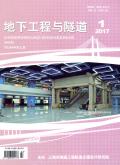Design and construction of cast in-situ steel fibre reinforced concrete headrace tunnels for the Neelum Jhelum Hydroelectric project
引用次数: 1
Abstract
Twin 10 km long parallel headrace tunnels were excavated as part of the headrace tunnel system for the Neelum Jhelum Hydroelectric Project, using two Tunnel Boring Machines (TBMs). The permanent support normally comprised a shotcrete lining applied over initial support elements. However, concrete lining was required in certain areas of extremely poor ground conditions. Once placement of conventionally reinforced concrete commenced, it was found to be taking longer than anticipated, prompting a search for alternative solutions. Steel Fibre Reinforced Concrete (SFRC) proved to be the most viable option for accelerating the concrete lining programme. This paper briefly outlines the requirement for a concrete lining in the aforementioned areas. It includes an assessment of the suitability of a conventionally reinforced concrete lining versus an SFRC lining, the design basis, and the actual design itself. A comparison of the costs and durations to install the two types of lining is also presented. 1 PROJECT DESCRIPTION AND OVERVIEW The Neelum Jhelum hydroelectric project is located in the Muzaffarabad district of Azad Jammu & Kashmir (AJK), in northeastern Pakistan. Geographically, the area consists of rugged terrain between 500 and 3 200 m in elevation within the Himalayan foothill zone known as the Sub-Himalayan Range. The project is a run-of-river one, employing 28.6 km long headrace and 3.6 km long tailrace tunnels to cut off a major loop in the river system, transferring the waters of the Neelum River into the Jhelum River, for a total head gain of 420 m (Figure 1). The headrace tunnels comprise both twin (69 %) and single (31 %) tunnels, while the tailrace tunnel consists of a single tunnel. Design capacity of the waterway system is 283 cumecs. The project, which was completed in 2018, has an installed capacity of 969 MW, generated by four Francis-type turbines located in an underground powerhouse. At commencement of construction in 2008, all tunnels were to be excavated using conventional drill & blast techniques. However, it soon became apparent that with the equipment being employed, a 13.5 km long section of the headrace twin tunnels underlain by high terrain that precludes construction of additional access adits, would take too long to excavate. Consequently, the construction contract was amended to allow the operation of two 8.5 m diameter open gripper hard rock TBMs to each excavate some 10 km of the twin headrace tunnels (Figure 1), with an initial centre-to-centre lateral spacing of 33 m, later increased to 55.5 m. The tunnel excavation diameter was 8.5 m diameter giving a total face area of 56.75 m. Excavation direction was upstream to promote drainage, with a typical gradient of 0.8 %.Neelum Jhelum水电工程现浇钢纤维混凝土引水隧洞设计与施工
作为Neelum Jhelum水电项目引水隧道系统的一部分,使用两台隧道掘进机(tbm)开挖了两条10公里长的平行引水隧道。永久支撑通常包括喷射混凝土衬里,覆盖在初始支撑元件上。然而,在某些地面条件极其恶劣的地区,需要混凝土衬砌。一旦开始常规钢筋混凝土的安置,就发现需要比预期更长的时间,这促使人们寻找替代解决方案。钢纤维增强混凝土(SFRC)被证明是加速混凝土衬砌方案最可行的选择。本文简要概述了上述地区对混凝土衬砌的要求。它包括对传统钢筋混凝土衬砌与SFRC衬砌的适用性评估,设计基础和实际设计本身。并对两种衬砌的成本和工期进行了比较。Neelum Jhelum水电项目位于巴基斯坦东北部的Azad Jammu & Kashmir (AJK)的Muzaffarabad地区。从地理上看,该地区由海拔500至3200米的崎岖地形组成,位于喜马拉雅山麓地带,被称为亚喜马拉雅山脉。该项目是一个河流工程,采用28.6公里长的源头和3.6公里长的尾流隧道来切断河流系统的主要环路,将尼勒姆河的水转移到Jhelum河,总水头增益为420米(图1)。源头隧道包括双隧道(69%)和单隧道(31%),而尾流隧道由单隧道组成。水路系统设计容量283立方米。该项目于2018年完成,装机容量为969兆瓦,由位于地下厂房的四台弗朗西斯式涡轮机产生。在2008年开始施工时,所有隧道都使用常规的钻孔爆破技术进行挖掘。然而,很快就发现,随着设备的使用,引水双隧道中有一段长13.5公里的路段由于地势较高,无法建造额外的入口坑道,挖掘时间太长。因此,施工合同进行了修改,允许使用两台直径8.5米的开放式抓手硬岩掘进机,每台掘进机挖掘约10公里的双引水隧道(图1),初始中心到中心的横向间距为33米,后来增加到55.5米。隧道开挖直径8.5 m,总开挖面面积56.75 m。开挖方向为上游,以促进排水,典型坡度为0.8%。
本文章由计算机程序翻译,如有差异,请以英文原文为准。
求助全文
约1分钟内获得全文
求助全文

 求助内容:
求助内容: 应助结果提醒方式:
应助结果提醒方式:


